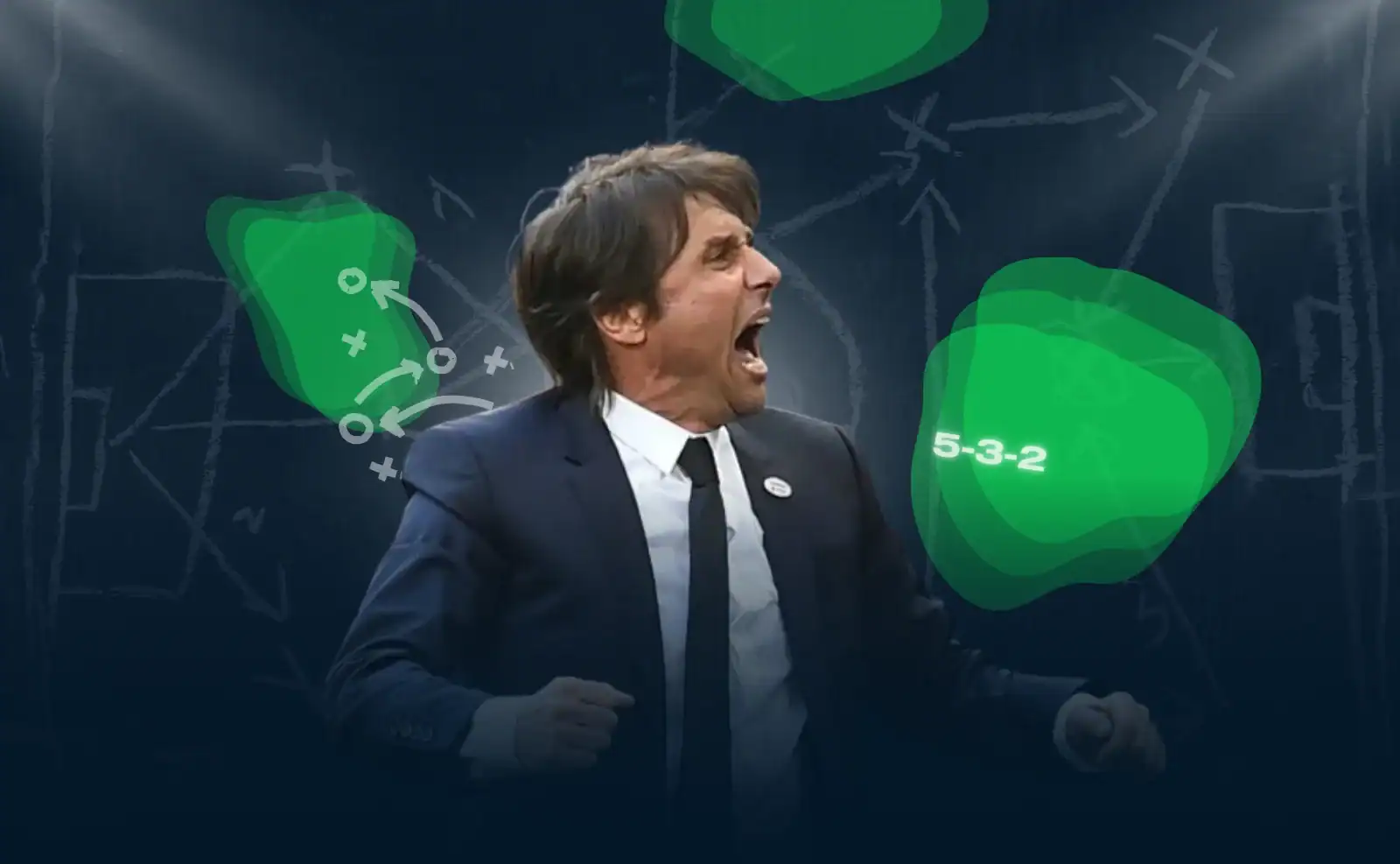The 5-3-2 tactic, also known as the 532, is attracting interest among soccer professionals, especially for its versatility and its ability to balance the team both defensively and offensively. This strategy, used by well-known coaches, is often debated for its tactical effectiveness.
After covering several other formations like the 4-2-3-1 and the 3-4-3, we’ll now take a close look at the 5-3-2 to explore how it works, its origins and more.
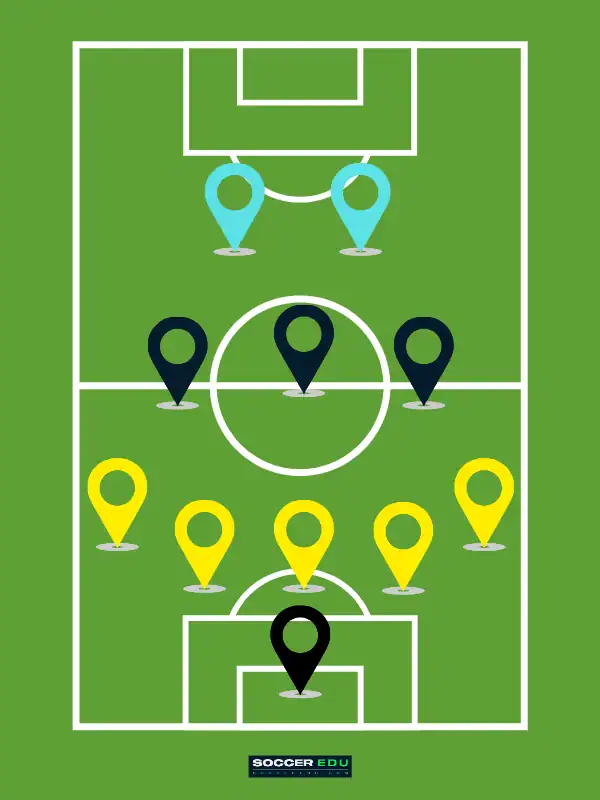
Who is behind the creation of the 5-3-2?
The 5-3-2 has its roots in Italian soccer. The arrival of Catenaccio (a distinctive Italian style of play) left a strong mark on the game during the 1930s and 1940s. Although this system isn’t identical to the 5-3-2, it laid the structural foundations and influenced coaches and their tactics.
Catenaccio is a system built on a solid defense and quick counterattacks. Coach Helenio Herrera is often associated with the term, particularly for applying this system at Inter Milan in the 1960s.
What is the 5-3-2?
This formation, characterized by its defensive nature, consists of three clearly defined lines:
- 5 defenders: Among these five players, there are three central defenders who protect the central area by containing the opposing attacks. These defenders are supported by two fullbacks with a fairly hybrid role. Their objective is to contribute defensively by strengthening the backline, but they also take part in offensive plays by advancing along their flanks to provide attacking options on the wings.
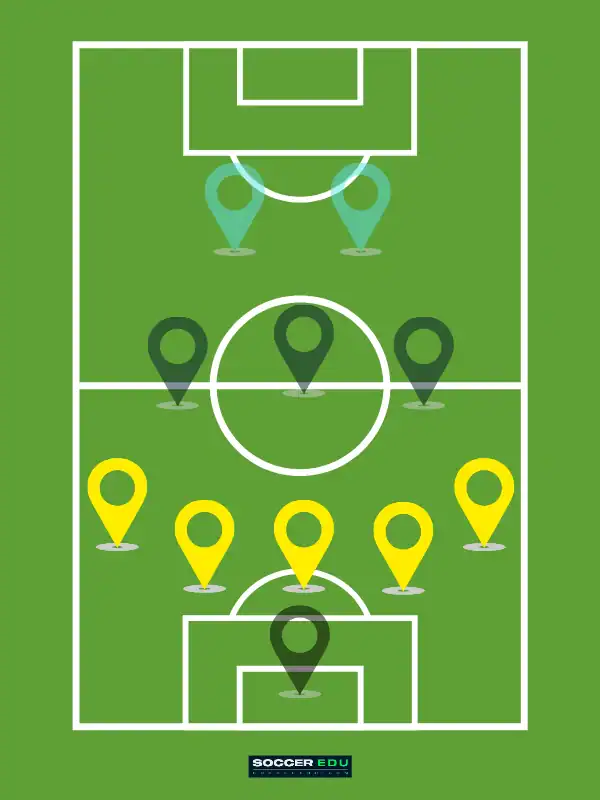
- 3 midfielders: among these three positions, there are usually one defensive midfielder who acts as a shield in front of the defense, providing balance to the team’s shape. The other two midfielders have more offensive and versatile roles. They possess advanced technical skills that allow them to direct the play and operate effectively in tights spaces. Defensively, this pair supports the team during pressing phases.
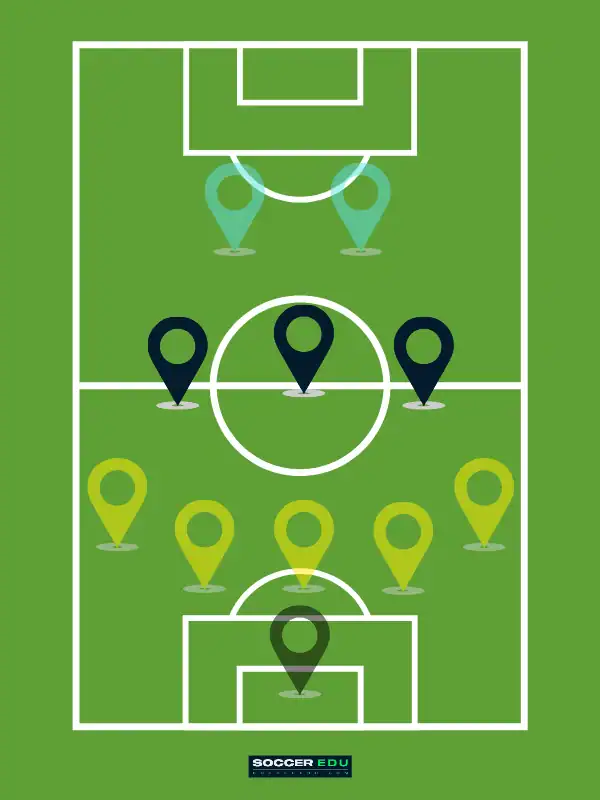
- 2 forwards: The spearhead of the team is based on two different profiles. The forwards do not share the same role but are complementary. Among these profiles, there may be a forward playing as a pivot who aims to hold up the ball and a quickest striker who looks to attack the space in behind. The primary role of these forwards is to finish attacking moves; however, they are also called upon to press the opponent’s first defensive line.
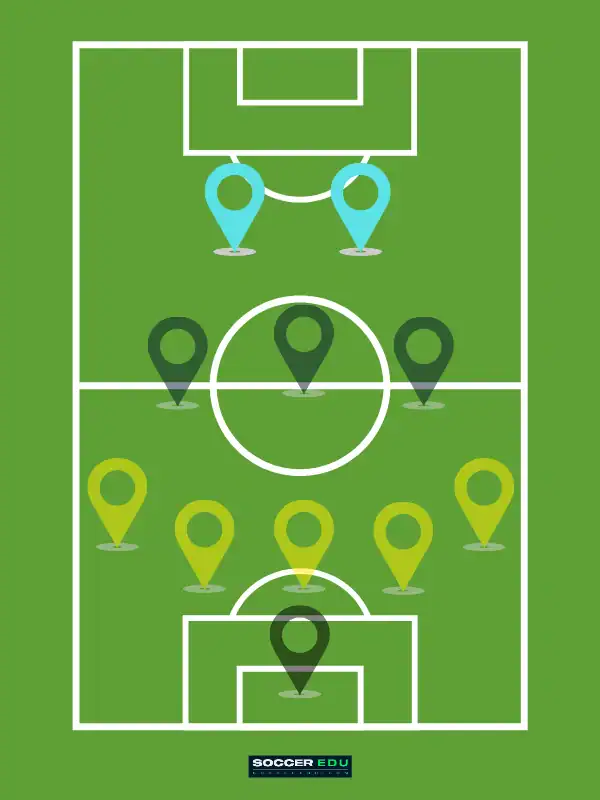
This formation offers defensive solidity with a reinforced back line made up of 5 players. However, this system is not limited to providing defensive stability, notably due to its tactical flexibility.The 5-3-2 encourages the use of width by taking advantage of the full-backs’ positioning, who contribute to building attacking opportunities.
How to play the soccer 5-3-2 formation?
The 5-3-2 is based on a balance between defense and attack; here is the tactical setup for each line:
- Defensive organization: Due to their number, the central defenders cover spaces with a tight positioning and close down dangerous zones for the goalkeeper. This central density makes it harder for attackers to find space and win duels. Having three central defenders provides defensive security. Indeed, if one defender steps out to press a player, the other two can cover in case he is bypassed. The fullbacks contribute to this defensive work by closing down the flanks to prevent wingers from advancing. They are also crucial in defensive recovery, especially during counter-attacks.
- Midfield-to-attack transition: Among the three midfielders, the one positioned deepest (defensive midfielder) aims to recover the ball. To do this, they either position themselves to intercept passing lanes or engage directly with the opponent. Once the ball is recovered, they initiate the offensive transition by passing to the other midfielders or the forwards. These two midfielders create chances by exploiting space, directing play and distributing passes to the forward or fullbacks. In defensive situations, these two players drop back to form a block with the third midfielder.
- Role of forwards: The 5-3-2 favors quick transitions, initiated by the midfielders who rapidly direct play towards the fullbacks or the forwards. The forwards must be ready to receive the ball and use it effectively. The pivot forward acts as a focal point, shielding the ball and passing it to a teammate. The other forward, generally more technical or faster, positions themselves smartly to receive the ball from the pivot and directly challenge the opposing defenders.
The 5-3-2 is a defensively oriented formation. Teams using this system are prepared to absorb a lot of pressure during the match and play a style based on quick transitions. These teams must therefore be efficient in front of goal by maximizing the opportunities created by the team.
Variations of the soccer 5-3-2
The 5-3-2 is a versatile formation; coaches can adapt it based on the opponent by adjusting the player’s roles and positions according to the desired objectives.
The 5-2-1-2
The 5-2-1-2 formation allows for greater creativity in midfield. The defensive midfielder is replaced by an advanced playmaker, which helps to energize and promote the creation of scoring opportunities.
The 5-4-1
The 5-4-1 is a formation used in situations where the team is focused on not conceding goals. One of the forwards is sacrificed to add a defensive midfielder, providing extra security through a more compact structure.
The 3-5-2
The 3-5-2 is a more attacking system where the midfield is reinforced with full-backs who turn into wing-backs. These wing-backs operate like wingers in offensive situations, which has a direct impact on the quality of the chances created.
How to counter a 5-3-2?
The 5-3-2 system is generally used by a team determined not to concede goals and relying on fast attacking situations or counterattacks to score. As a result, it can be challenging to find the net against a team that plays in a 5-3-2 formation.
However, there are strategies to break down teams that use this system:
- Exploit the space on the wings: The biggest weakness lies on the flanks. When the wing-backs push forward to support the attack, they often leave large gaps behind them. In case of a counterattack, exploiting these open lanes can be an effective way to penetrate the five-man backline.
- Play through the middle: Since teams in a 5-3-2 formation tend to concede possession to their opponents, attacking through the center of the field can be an effective strategy. By patiently building up play with quick combinations and technically skilled players, the central defenders can be put under pressure and forced into mistakes.
The 3 best formations against a 5-3-2
The 4-3-3 formation
The 4-3-3 is a setup that stretches the opposing defense block, especially through the positioning of its wingers. It is therefore wise to use it against a team playing in a 5-3-2 formation to force the opposing wing-backs to stay deep. This formation can effectively exploit the weaknesses on the flanks of a team using the 5-3-2.
The 4-2-3-1 formation
The 4-2-3-1 is a balanced formation that combines defensive solidity with offensive creativity. This setup is effective against against the 5-3-2 because it helps block offensive transitions and takes advantage of the spaces between the lines.
The 3-4-3 formation
The 3-4-3 is a very attacking formation that forces the opposing wing-backs to stay back, limiting their ability to contribute to attacks. Additionally, the midfield line of four can match the central density of the 5-3-2, helping control the game in the middle of the field.
Which teams play in a 5-3-2?
- Juventus in the 2010s: Coached by Antonio Conte, this team dominated Serie A using the 5-3-2 system. Their defense was considered nearly impenetrable, with a squad featuring renowned players such as Giorgio Chiellini, Leonardo Bonucci, Stephan Lichtsteiner and Carlos Tévez.

- Argentina at the 1986 World Cup: During this tournament, La Albiceleste played with a 5-3-2 system to strike a balance between defense and attack. This tactic was specifically designed to maximize the impact of Diego Maradona’s brilliance.
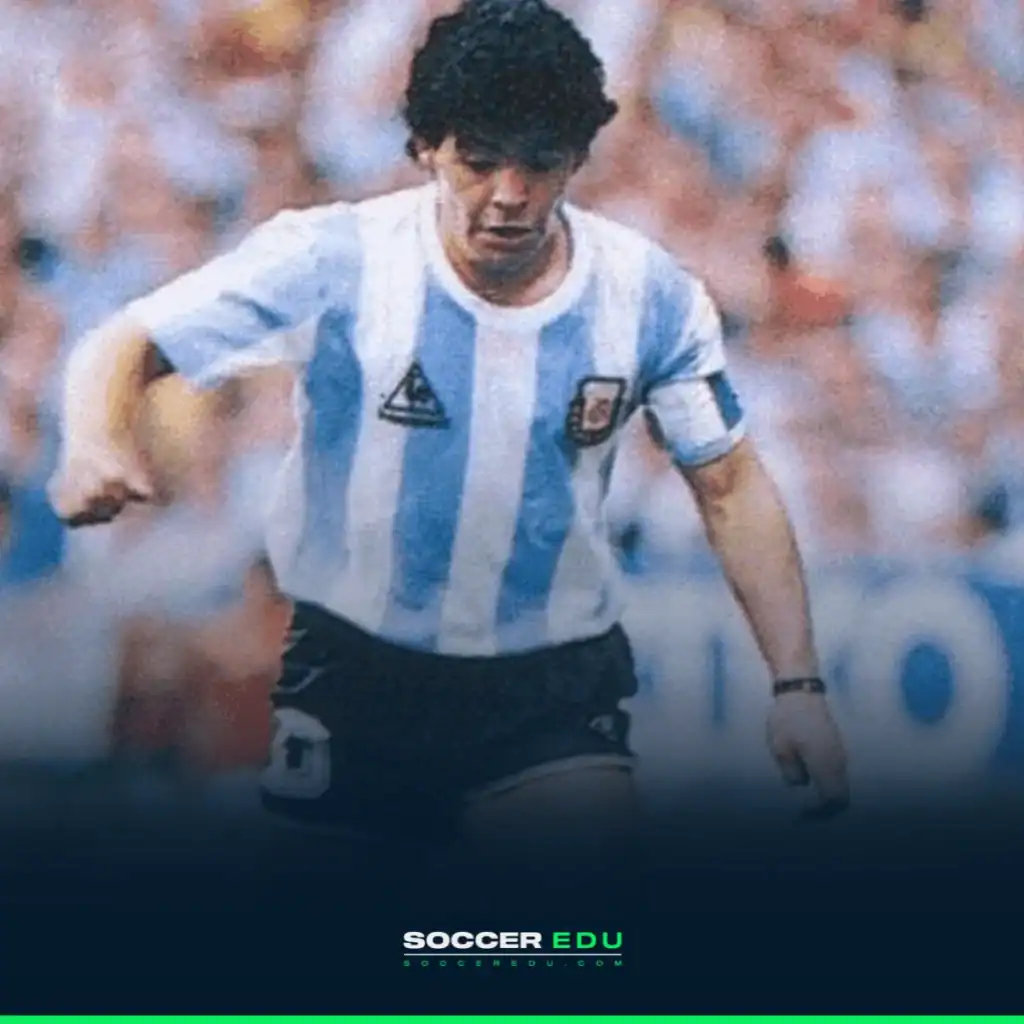
- Italy at Euro 2020: Roberto Mancini’s Italy mostly played in a 4-3-3 formation during the tournament. However, the system was quite hybrid and could shift into a 5-3-2 late in matches to secure the result by closing down the game.

- The 5-3-2 remains a rarely used formation in MLS, but it was the second most employed tactical setup by Nashville SC during the 2024-2025 season, having been used in three matches. Its rarity can make it difficult for opponents to anticipate, and when well executed, it offers strong defensive solidity as well as significant counter-attacking potential, as previously discussed.


